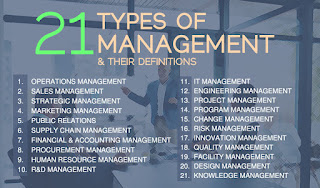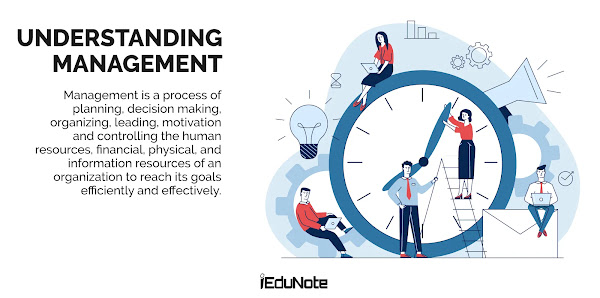What is management?
Management is the process of planning and organising the resources and activities of a business to achieve specific goals in the most effective and efficient manner possible. Efficiency in management refers to the completion of tasks correctly and at minimal costs. Effectiveness in management relates to the completion of tasks within specific timelines to yield tangible results.
Characteristics of management
Some of the fundamental characteristics of management are as follows:
Multi-dimensional
Most management oversees and supervises a company or organisation's service or production cycle. Managers work closely with and provide guidance to the members of their team. A manager considers a staff member both as an individual with diverse needs and as a component of the larger group. To be effective, managers influence their team members to apply their unique strengths toward achieving the organisation's goals.
Dynamic
Management is a dynamic function and evolves and adapts to changes in its environment, whether they are economic, socio-political or technological. For instance, a paper company could see a decline in sales because of the rapid adoption of screens and digital devices. Whether the company can still survive depends on how effectively its management can adapt to new market requirements.
Intangible
Management is not a tangible product, but its presence can change the way an organisation functions. Management consists of ideologies, policies and human interaction. Good management helps improve a company's target achievement ratios, employee gratification levels and overall ease in the company's operation.
Objectives of management
Management can have mainly three types of objectives:
Organisational objectives
Management should consider the interests of all company stakeholders, including employees, customers and the government. Managers are responsible for setting and achieving goals for the organisation. Typically, the primary aim of an organisation is to achieve growth by utilising its human, material and financial resources. There are three general organisational objectives for any company:
Survival: An organisation needs to generate enough revenues to cover its operational costs.
Profit: Profit provides incentive and is essential for covering unprecedented costs and risks associated with running a business.
Growth: You can measure the growth of a business in terms of increases in sales volume, workforce and capital investment.
Social objectives
To an extent, the management is also responsible for creating benefits for the society through their work. Companies choose to do this in different ways. Some may incorporate environment-friendly methods of production, while others implement fair wages and opportunities. Larger companies often maintain or fund initiatives that provide basic amenities like healthcare and education. Based on the scale of their operations, companies often initiate CSR (Corporate Social Responsibility) campaigns that benefit society in different ways.
Personnel objectives
The management typically decides the financial incentives, salaries, perks and social initiatives for their employees. Activities that improve peer recognition and interaction like corporate outings and holiday bonuses cater to the personnel's social growth and development.
Importance of management
Here are some reasons management is important:
Helps in achieving group goals: Effective management gives a common direction to individual efforts and guides them towards achieving the overall goals of an organisation.
Increases efficiency: Efficiency reduces costs and increases productivity in all spheres of an organisation's work.
Creates a dynamic organisation: Management helps its personnel in adapting to change so that the organisation continues to maintain its competitive edge. How well an organisation can respond and adapt to change can mean the difference between its success and failure.
Helps in achieving personal objectives: Effective management fosters team spirit, cooperation and commitment to achieve the organisational goals as a group, which helps each term member achieve their personal objectives.
Levels of management
Management roles come in three levels:
1. Top management
Typically, the senior-most executives in a company are the chairman, chief executive officer, chief operating officer, president and vice-president. Their role lies in integrating diverse components of the company and coordinating activities of different departments. They also analyse the business environment and its implications to formulate goals in order to ensure the survival of the company and the welfare of its stakeholders.
2. Middle management
Mostly composed of division heads, the middle management links the operational management to the top management. Division/department heads receive guidance from top managers and are leaders to operational managers. Their job is to understand the policies framed by the top management and relay them to their respective divisions/departments to ensure that they follow through with company policies and decisions.
3. Operational management
Supervisors, section leads or forepersons directly oversee the efforts of the workforce. They are responsible for quality control and ensure that the work meets deadlines. The top management draws out the plans that define the authority and responsibility of supervisors.
Functions of management
The purpose of management is to unify the efforts of different individuals in an organisation towards achieving a common goal. These are some functions of management:
Planning
Planning involves creating a timeline of tasks that need to be completed to achieve a specific goal. Managers execute planning Planning should be carried out in a systematic fashion to avoid wastage of resources and time. A detailed plan of action minimises confusion, risk, wastage and uncertainty.
For example, the top management in a small business may set a high sales target for one quarter to compensate for the previous quarter's losses. A start-up's founder may plan to make formal efforts to associate with the government and other large institutions to expand the scale of their operations. Heads of local digital marketing companies may plan to create an international market for their products and services. An IT company may decide to update their work regulations to accommodate work-from-home for their employees.
Prioritise organisation
The objective of organising is to nurture a symbiotic relationship between the personnel, financial and physical resources of the company. Proper organising provides the course of action that meets all parameters for success. Organising involves the identification and classification of business activities, delegation and coordination.
For instance, the top managers may allocate funds or resources to different branches. The branch managers must then allocate funds to departments within the branch, depending on their operational requirements. The department heads then track the day-to-day expenditure of the funds.
Improve staffing
Staffing involves recruiting and building a team for the organisation. The staffing process of companies is often lengthy and in-depth. Management identifies professional roles in the company and the skills/qualities required to perform well in these roles. The manager then selects staff for those roles through the recruitment processes. Once selected, candidates undergo training and join the company's workforce. Managers are also responsible for awarding appraisals and promotions as part of staffing.
For instance, a digital marketing company might choose to expand its operations to other cities in the country. The top management can then decide to recruit five marketing personnel, four visual designers, two accounting personnel, a human resource professional and a manager for each location. They may also decide to outsource IT, maintenance and security related work to freelancers. The company's staffing guidelines may also suggest that one marketing personnel and one visual designer should move to the role of department lead, after two months of training and one year of experience in the company.
Provide direction
Supervising, motivating and guiding the staff members is central to the functions of a manager. Directing involves taking the steps to put the work in motion and maintain productivity to achieve company goals. This requires excellent leadership, communication and interpersonal skills to drive the team towards completing organisational objectives.
For example, the middle management often makes policies based on directions they receive from the top management. Operational managers focus more on managing the day-to-day functioning of the company.
quality
Businesses function on some established standards of performance. A manager ensures that the staff's collective output meets quantity and quality benchmarks set by the company. Control at each level prevents overall deviation from prescribed quality specifications.
For example, supervisors in a fast-food chain often micro-manage cashiers, cooking staff, delivery personnel and servers to make sure that the food and service in their branch meet quality standards. Top management prescribes these quality standards and they usually evolve with time.














